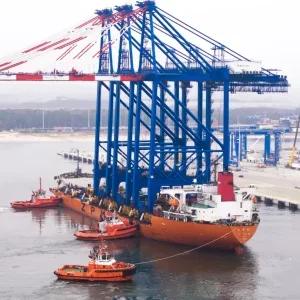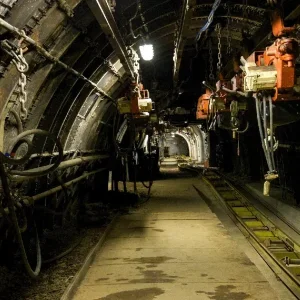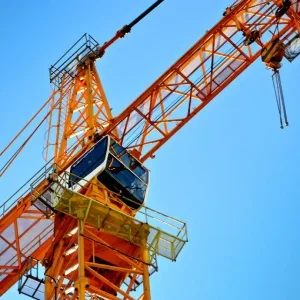The lift arms are pivotally connected to a hub (44, 44B) to swing vertically. Each hub is mounted to rotate on a vertical support shaft (38) central between the ends of the loadspreader (40) or hooking and lifting links (46, 46D) for each end of a load. A hydraulic cylinder (48) or ropes (168) connects each lift arm to its hub to lift and lower the arms together to lift and lower the spreader substantially level or oppositely to end dump special containers.
The hubs can be rotated relatively horizontally to move the loadspreader sidewise parallel and/or turn it to align a load. A rotary crane (18) carries the lift linkage about a support pivot with parallel positioning control to translate the loadspreader over a circular area and with control to extend or retract the loadspreader sideways.
Description
This is a top transfer device and system for transferring such things as cargo and dump containers and semitrailers between rail cars and other vehicles, driveways, or storage spots. This invention includes improvement to the suspension and positioning of the loadspreader or hooking bails for alignment with a vehicle through a greater arc of rotation of the crane and is generally applicable to the inventor’s pending patent applications.

Fig 1 – side elevation of a crane mounted on a common pivot post transferring cargo containers between a rail car, conveyor and storage stack.
Fig 2 (top) – plan view of a crane mounted on a common pivot post transferring cargo containers between a rail car, conveyor and storage stack.
Fig 3 – a vertical section of the preferred mount of the crane arms about the pivot post.
Fig 4 – a section on line 4-4 of Fig 2 to larger scale.
It is an object to provide a simple and cheaper loader than the inventor’s preceding applications, to reduce the height required for a given lift, to provide sideways movement of the loadspreader without changing its height appreciably or radially moving the pivot point over the loadspreader to eliminate adjustment to compensate.
It is an object to eliminate the vertical sliding lift shaft (38), its lift arm (42), the transverse swinging links (70) or the hinged positioning arms.
As a result of these improvements, sliding frictional and off balance twisting forces, the height of the crane required to stack containers to a given height, the weight of the crane and hoist, and the cost is reduced.
It is an object to attach the lift to each end of the loadspreader, instead of the centre, so that a lighter loadspreader will suffice and in such a way that the loadspreader can be telescoping. It is an object to control the tilt of the loadspreader lengthwise by control of a lift cylinder for each end.
It is an object to provide this invention for rotary cranes mounted on a common pivot support to provide fast successive transfer with successive cranes revolving around the support pivot for transfer of stacked containers over the same spot with least interference and transfer time.
Furthermore, it is an object to combine the lift, transfer positioning and limited rotation of the loadspreader in one double swivel lift linkage. Plus, provide a crane and hoist which can reach over the top of stacked containers to those below and beyond.
These, and other objects and features, should become evident to those skilled in the art by study of this specification with reference to the drawings.
Technical illustrations
Referring to the drawings and in particular to Figs 1 and 2 where a rotary loader (18) is positioned to transfer cargo containers (20) between vehicles or railway cars (22) on a driveway and/or track (24) and one or more conveyors (26). The cars can be moved by a car mover or locomotive to the approximate position shown or the loader can be a vehicle as will be described later.
The loader has one or more cranes (28) mounted on a pivot post (30) on top of a vertical column (32) or suspended vertical from a vehicle. Three cranes are shown in Figs 1 and 2, each having a radial supporting arm (34) integral with an offset bracket (36) nested to turn on pivot (30).

Fig 5 – plan view of the loadspreader and sideways shifting hoist of Figs 1 and 2 to a larger scale.
Fig 6 – side elevation view of the loadspreader and sideways shifting hoist of Figs 1 and 2 to a larger scale.
Fig 7 (top) – a bottom sectional view taken on line 7-7 of Fig 6.
A dependent vertical load support shaft (38) is mounted, fixed on the outer end of the support arm or crane. A loadspreader (40) is supported substantially horizontally by two lift arms (42) each pivotally mounted on a pin (43) to an offset bracket (44) both mounted to turn on one or more collars (45) pinned on shaft (38).
Depending links (46) suspended to swing on pins (46P) through the outer end of each lift arm (42) depend to a swivel connection (47) supporting each end of the loadspreader (40). A hydraulic cylinder (48) is connected between each lift arm (42) and its offset bracket (44) to lift and lower arms and loadspreader.
Referring to Fig 3, the weight of each of the cranes on pivot (30) can be stacked or preferably they are separately carried on colunm (32) or pivot (30) by flanged bushings (50 and 51) carrying the weight of the second and upper cranes respectively.
Referring to Figs 1, 2 and 4, each crane has a large beveled gear (52) fixed on a bracket (53) to turn around on shaft (38) below arm (34) and one shared and equal beveled gear (52), of the same number of teeth and pitch as gears (52), secured concentric on pivot (30) upside down.
Smaller beveled gears (54) and shafting (56) connect beveled gears (52) to beveled gear for each arm to rotate its beveled gear to turn its bracket (53) one revolution oppositely for each revolution of the crane about the pivot post (30) to cancel the crane’s turning the hoist.
Each offset bracket (44) is pivotally connected by an air or cushioned hydraulic cylinder (66) to the gear driven collar bracket (53) to turn lift arms (42) laterally to one side or the other to shift the loadspreader to that side and back as needed to extend over car (22) for transfer and retract to the side to clear the car for movement lengthwise or to clear adjacent vehicles preferably before the crane is turned from over a stationary vehicle.
As each crane is rotated about the pivot post its loadspreader is held parallel to translate by the beveled gearing connected when the loadspreader is parallel to track 24 with bracket 53 extended transversely to the loadspreader as in Fig 2.
Applications
There are many possible variations and applications of this invention and in degrees of control and features desired.
The hoist can be supported by a crane that can swing in and out relative to the pivot post (30) using swinging links.
The hoist can be kept parallel if desired as it is revolved around pivot 30 by sprockets and chains connected.

Fig 8 – a side elevation of the hoist with bails engaging a preferred end dump container.
The hoist for this type of mounting is simplified by combining brackets (44) into one bracket (44B) and omitting cylinders (66). Both arms (42) are pivotally mounted on bracket 44B to swing in the same or parallel vertical planes.
Fig 8 also illustrates a hooking system that eliminates the loadspreader and uses special containers (20D). These containers each have four cam lift hooks (140), one on each top corner along the side at or near each top corner with open end facing in from the ends curved up to cam into a pocket for engagement by a link or bail (46D) replacing links (46) on the hoist.
These containers are adapted for end dumping with end door (144) mounted to swing out at the bottom on hinge pins (146) at the top between the sides. With open top containers, bulk loads can be loaded higher than the sides, therefore, a bale (46D) is provided for each hook (140) to leave space for the load to be mounted above the sides of the container.
A cylinder (156) is pivotally connected between each arm and its bales (46D) connected by a crossmember (158) to swing the bails inward and out lengthwise the hoist. Cylinders (156) can be single-acting with a compression spring (160) therein holding the bail normally inward, as in Fig 8, in position for aligning and engaging on top of container (20D) on car (22D).
Cylinders (156) are then pressured to swing the bails down and out, lifting arms as the pins or rollers (150) roll on top of the sides of the container up into hooks. Arms are then lifted to lift the container.
If the dumping angle is steep enough the container can have end slopes like bottom dump coal cars instead of an end door to empty.
There are various ways to hydraulically power and control the cylinders.
Where a hoist is turned around and round on arm, rotary joints, which are of standard manufacture, can be used to connect hydraulic lines between the pivot post and the arm and between the shaft and the cylinders or between the arm and rotary shaft.
The hoist can be radio controlled from a transmitter in a truck cab or held by an operator on the ground or in a control station conveniently located as on or in column 32, in which case the column could have a balcony or be enlarged with windows around under the hoist arms for the operators.
Features can be omitted where not needed or added where needed. With transverse movement of the loadspreader provided by a trolley or other means, such as swinging links, the lift arms (42) and links (46) can be restricted to a plane parallel to the loadspreader and accordingly links (46) are pivotally connected directly to the loadspreader and brackets.
Lifting and control ropes can be subsituted for air or hydraulic cylinders. The cylinder can be an air cylinder connected between the arm and its swing compensating the link to control the swing of the links. Brackets could extend oppositely from pivot (38) with a cylinder (66) on each side of the pivot substantially parallel to the arms to reduce the width of the hoist for a wide swing of arms.
Inventor, Leonard D. Barry, adds: “Having described some embodiments and applications of my invention I do not wish to be limited to those disclosed but intend to cover this invention by claims to cover all variations, applications and parts which are within the spirit and scope of this invention.”
About the patent
US patent application number 09/445,244 was originally filed on December 3 1999. Barry, who has somewhere in the region of 60 patents to his name, is still looking to sell the patent rights. Interested parties should contact him at the Bi-Rail Company, 19300 Pennington, Detroit, Michigan 48221, USA.
Disclaimer
As edited versions of the originals, this text and supporting illustrations may omit technical or legally important detail.






